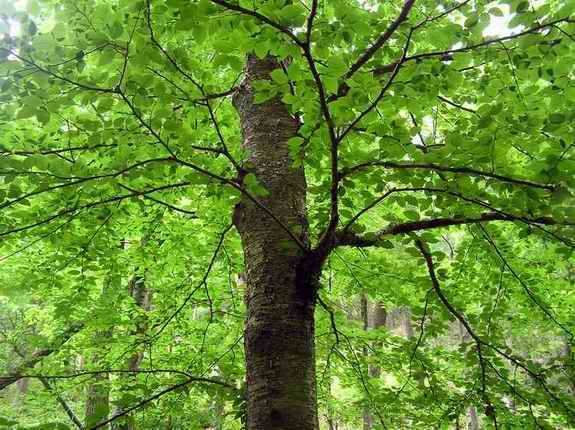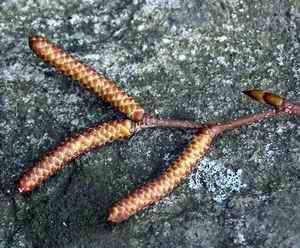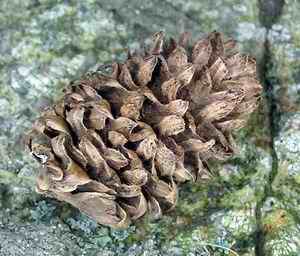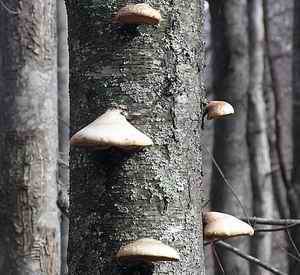|
Return to Hiker's Notebook Home Page
Common Name: Black Birch, Cherry Birch, Sweet Birch, Mountain Mahogany - The darkened color of the bark of this species of birch as it ages is the source of the name Black Birch. It's resemblance to the Black Cherry is the basis for Cherry Birch. Scientific Name: Betula lenta - The generic name is from the Latin betula meaning birch tree which in turn derives from betu which means bitumen (tar found in a natural state) in the language of Ancient Gaul as the Gauls extracted dark sap that looked like tar from birch trees; The species is from the Latin lentus which means pliant and tenacious in reference to the toughness of the branches, which bend but don't break.
The Black Birch is also known as the sweet birch due to the sap that it exudes, similar to but less than half as sweet as the sap of the sugar maple; it takes about ten gallons of sap to make a pint of birch syrup. Birch sap was therefore rarely rendered into syrup but rather fermented into birch beer. A beer was also made by mixing a decoction of birch leaves with honey, imparting the same properties. According to a recipe in Martha Washington's Booke of Cookery, "this drink is very pleasant and also physical, first for procuring and appetite, & also it is an antidote against gravel and the stone."
Birch trees were tapped for their sap by Native Americans of the New World and Europeans of the Old, where the birch was considered sacred; trees were planted on graves so that the souls of the deceased could climb toward heaven. Russian villagers mixed the sap of the birch with mint leaves to produce a type of a traditional beverage called kvass (normally made from rye or barley) as a spring tonic. The inner bark of the birch is edible, and strips can be fashioned and cooked to create "birch noodles."
One of the olfactory appeals of the black birch is that the bark contains the chemical methyl salicylate, commonly called oil of wintergreen; the smell readily apparent when the twigs are broken. A tea redolent of wintergreen can be made by steeping birch twigs in water. Wintergreen oil was originally extracted from the wintergreen plant (Gaultheria procumbens), but the more abundant and tractable sweet birch supplanted it in the late 19th Century. The oil was used as a flavoring in chewing gum, gelatins, and candies. Methyl salicylate is now produced synthetically and salicylic acid is used commercially as a coupling agent in dyes and paints and as a preservative for glues and leather goods.
The methyl salicyclate of the black birch is a powerful medicinal, so much so
that it is toxic if too much is taken internally; a dose of about 5 grams can
be fatal to children. Related to the acetylsalicylic acid of aspirin, oil of
wintergreen has been used for centuries to treat a variety of conditions.
Cherokee chewed the leaves to treat dysentery and drank birch tea to treat
colds, Delaware used a bark decoction to purge the body as an emetic or a
cathartic and Iroquois used it for sore muscles.
Western folk medicine included oil of wintergreen remedies for everything from abdominal and mammary cancers to warts. Its primary use, however, was as a balm, liniment or ointment for arthritis and other muscle and joint pain, a viable medical application that is manifest in modern products such as Ben Gay, which is 30 percent methyl salicyclate and 8 percent menthol.
Black birch trees are monoecious, having both male and female flowers on the same tree. The male flowers are catkins that hang from slender twigs in the winter (top right). The female flowers appear later, their fertilization resulting in the formation of a small green cone. The cones shatter in the fall to release the seeds and are retained on the branches somewhat like pine cones (bottom right).
The wood of the black birch is very strong hard and compact, so much so that it is commonly given the name mountain mahogany. It is used for furniture, floors and interior paneling and is highly prized as firewood.
|



 Black
birch trees are subject to many pathogens; primarily fungi such as
Black
birch trees are subject to many pathogens; primarily fungi such as